“We cannot afford to be weak at sea. History has shown that whoever controls the Indian Ocean has, in the first instance, India’s sea-borne trade at her mercy and, in the second, India’s very independence itself.”…….
– Prime Minister Pandit Jawaharlal Nehru on board INS Delhi ( Former HMS Achilles)
THE WORD ‘navigation’ comes from the Sanskrit word ‘Navagati’ and India’s ancients were seafarers. Soon after Independence India’s first Prime Minister Pandit Jawaharlal Nehru who knew India’s history and how it was conquered from the seas, appreciated the importance of the seas for India, and respected the rich ancient maritime traditions with involvement with the oceans and the art of shipbuilding in its history, which goaded him to write the above lines when he took a passage to Indonesia in the cruiser INS Delhi.
It was in 1736, Lovji Nusserwanjee Wadia began the Wadia shipbuilding dynasty, when he obtained a contract from the British East India Company for building docks and ships in Bombay docks and two remain, with teak wood for the hulls that proved sturdier than the oak wood built ships abroad. The Wadias built many wooden sailing warships for Royal Navy(RN) like HMS Foudroyant and Minden at Bombay, but with the advent of steam propulsion the technology was denied to India.
With British ascendancy to power in India, the Indian shipbuilding was gradually destroyed and shipping industry became restricted to the export of Indian goods to Europe. One of independent India’s niche triumphs therefore has been the resurrection of naval ship design and building skills that were stifled during the colonial period.
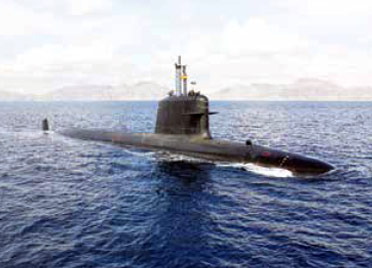
The Navy of independent India formed the Corps of Naval Constructors on November 23, 1956 as part of the Engineering branch of the Indian Navy, to undertake indigenous repair, design and construction of warships whilst simultaneously bringing the aspects of onboard maintenance of hull under the Corps.
Noted Naval Architects Shri Paramanandan, Shri Sam Dotiwala and Shri VS Dhumal were the pioneers of the nascent Corps. The first uniformed Naval Constructor in the Indian Navy was Late Cmde Ved Prakash Garg (1929–1983). While the first Constructor officers were trained at Royal Naval College at Greenwich, UK, Naval Architects from IIT Kharagpur were inducted from 1958 onwards. As the demands for increasing the strength of the Corps grew, the Navy recruited Engineers from other disciplines and trained them initially at IIT Kharagpur and later at IIT Delhi. The first such conversion course started in 1973. From a very modest beginning the Corps has grown today to a sizeable strength of about 300 men and women officers. The shipwright sailors about 100 are annually trained in their specialisation at the Navy’s Shipwright school at Visakhapatnam.
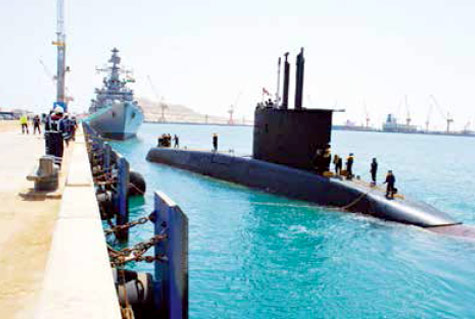
The Indian Navy has to be justifiably credited for its efforts to revive and ‘Make Warships and Submarines In India’, a decade and a half after gaining Independence. The Navy’s leadership had the vision to set up a design bureau in Delhi’s Greater Kailash with officers trained at IIT (Khargapur), in UK at Greenwich and Bath where RN had a design bureau and Russia’s world famous Severnoye, Rubin and Krilov Institutes to design and build ships in India. As of writing 30 warships are being built in India and none being imported except the two advanced Submarine Rescue Vessels from UK.
The Navy’s Corps of Naval Constructors completed 50 years on 17th Nov 2006 under the Director General of Shipbuilding and arranged an International Constructors Seminar in New Delhi. The invited Russian, American and British experts lauded the 350 strong Corps who are currently actively contributing in diverse fields such as ship and submarine design, construction, repair and maintenance, and also R&D in Naval research.
In a short span of half a century the Indian Navy boasts of an established ship design capability in the Naval design Directorate for surface ships and submarines (DGND) and which has been supported by the Weapons Electronics Engineering Establishment (WEESE) for electronics, software and communications. These two organistions under NHQ have supported and guided Indian Public Sector Shipyards (PSUs) and private shipyards to build and arm platforms which include Navy designed destroyers ( 3 Type 15s, 4 Type 17 Shivaliks, 6 elongated Leander frigates with missiles, 3 ASW P 28 corvettes and OPVs and survey ships, tankers and supported four conventional submarines of German design at Mazagon Docks Ltd and are designing the Project 75India submarines with AIP (Air Independent Propulsion . See list).
PRIVATE SHIP BUILDING
There are three main private sector players who have invested in shipyards in India. These include Pipavav Shipyard Limited (PSL) now Reliance Defence , ABG Shipyard Limited and L&T Shipyard. PSL is the largest shipyard in India and also one of the largest dry docks in the world. Two Goliath cranes of 600 T capacity each, service the dry dock and adjoining pre-erection berth, enabling PSL to handle up to 1200 T pre-outfitted ship blocks. PSL is using modern shipbuilding processes, including modular construction and line heating technique. Presently it has a order of 5 OPV orders.
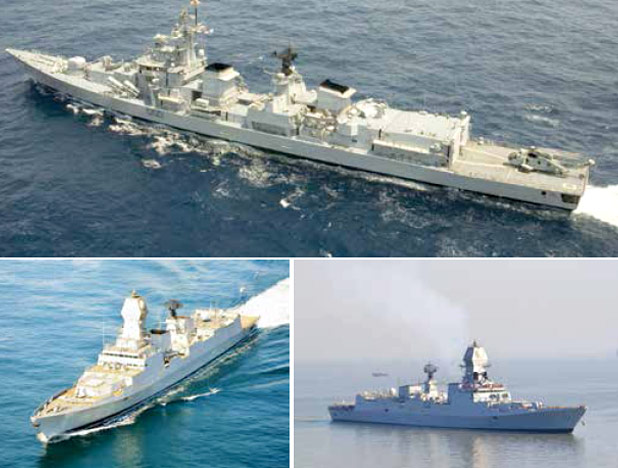
ABG Shipyard Ltd located in Surat in the state of Gujarat is also one of the largest with state of the art, manufacturing facilities including a “Ship-lift Facility” with a lift capacity of 4500 tons, side transfer facilities, CNC plasma cutting machine, Bending rolls, Hydraulic press, Cold shearing machine, Frame bending machine and steel processing machinery. The ABG Shipyard has successfully delivered three pollution control vessels and Interceptor Boats (45 knots vessels) in Aluminum hull with Water Jet Propulsion to the Indian Coast Guard and has orders for three Naval training ships but has declared bankruptcy.
There has been successes in private ship building for L&T (Larsen & Toubro) which has two yards, one at Hazira, Gujarat and Kattupalli Shipyard located near Ennore Port in Tamil Nadu. The company has projects from the Coast Guard to manufacture 7 OPVs and 36 high speed “interceptor” vessels which can travel up to 45 knots per hour. The facilities at the shipyard include pre-fabrication such as shot blasting and priming, CNC cutting, and a slipway to launch the vessels along with a jetty for outfitting jobs for the ships under construction. L&T has builds nuclear submarines under Naval supervision under DRDO.
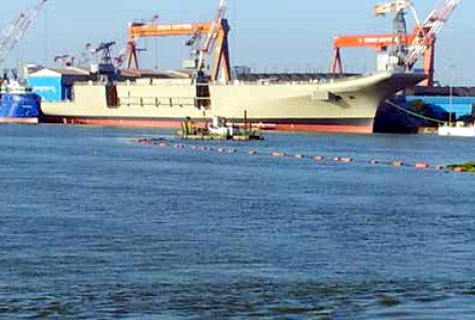
India’s versatile Constructor officers have even played a role in the naval variants of the country’s prestigious Guided Missile Programmes on warships, and the successful fitment of BrahMos on surface ships ( 4 Rajput class, 3 under construction 4Type 15Bs, and 3 Krivacks at Yantar and the fitting the B-05/K-15 underwater 750 km nuclear tipped twelve missiles on India’s first made in India nuclear submarine INS Arihant built at the Ship Building Centre (SBC) Vishakapatnam which was commissioned in 2016 are operational successes.
India has commissioned the three Project 28 indigenously made anti-submarine corvettes -INS Kiltan, Kamorta and Kadmatt At GRSE which have 90% indigenous content and last Kavaratti will be more modern, with a new light weight mast and will be commissioned end of 2018. The project was approved in 2003, and first ship – INS Kamorta and second- INS Kadmatt were commissioned in 2014 and 2016 respectively. The remaining one INS Kavaratti is under construction and is slated to be completed by the end of 2017.
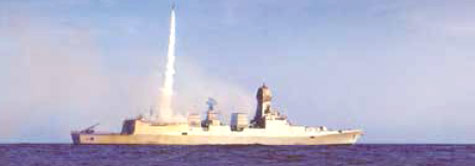
The Naval designers took on The DRDO-Navy Project Akshanka (Hope) formerly the classified Advanced Technology Vehicle (ATV) nuclear submarine project which is guided by PMO to build two more larger than Arihant nuclear submarines at the Ship Building Centre (SBC) Vishakapatnam hived out of the sprawling Naval Dockyard in a Public Private Partnership (PPP) with the Engineering giant Larsen and Tubro (L&T). The 85MW nuclear reactor is supplied from BARC, the turbines from BHEL and many ancillary Indian industries with Russian consultants. Currently India is on the threshold of completing its first indigenous aircraft carrier 37,500 ADS Project 71 Vikrant at Cochin Shipyard Ltd ( See latest April picture).
The Government after Independence took over the repair yards left by the British and therefore Indian Navy and the private sector was barred from ship building, which was termed a strategic industry till the early 1970s. The Mazagon Docks Ltd took over the building of Leanders with design from Yarrow Shipyard at Glasgow and to lessen dependency on imported warships and support the three Government controlled Public Sector Shipyards(PSUs), namely MDL at Bombay, GSL at Goa and GRSE at Calcutta.
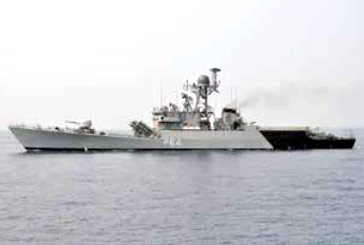
The Ministry of Shipping set up a green field shipyard at Cochin with Japanese aid and Mitsubishi collaboration specifically for merchant shipbuilding, and the yard is currently engaged in building India’s first 37,500aircraft carrier INS Vikrant with rising costs and delays. I has been a most challenging task, not undertaken before. Fincantieri is assisting in meshing the four LM-2500 engines with the gear box and Mactaggart Scott UK is assembling the side aircraft lifts for the MiG-29Ks and the diesel generators are being supplied by Wartsila of Finland.
A 30 year Submarine Building Plan (1999) document for two line submarine building was also issued after the confidence shown by the designers. Navies need long term strategic plans and sustained funds as the gestation period of building ships is long and setting up building yards, is a capital intensive and risky propositionThe pride of the Naval Make in India programme are three Shivalik Project Type 17 home designed and home built frigates with Klub and Barak AA system missiles with Elta supplied AMDR radar can be ranked as equal to latest in the world. All ships have Bharat Electronic Let(BEL) sonars and Israeli or Russian EW systems. are already installed on ships. Seven Type 17A with assistance from Fincantieri will be constructed in modular manner at Mazagon Docks Ltd and Garden Reach Shipbuilders and Engineers Ltd (GRSE). ond line Project 75 India to augment the submarine force in the long term is still to be progressed.
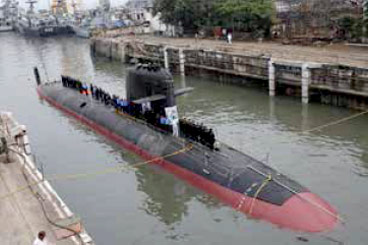
“By virtue of its inherent attributes, Indian planners have been at pains to explain that naval power is generally self-contained not only to deal with security challenges across the maritime ‘spectrum of conflict’, but also for its government to achieve geo-strategic objectives beyond these, in peace. This stems from the wide range of options that the Navy offers to its government – while its versatility enables transposition of roles ranging from ‘military’ to ‘constabulary’ and from ‘diplomatic’ to ‘benign’, its attributes of reach, sustenance and poise in international waters enable power-projection in a calibrated manner. The Indian Navy appears to be getting ready for the task.
– Cmde Ranjit B Rai (Retd ) is former Director of Naval Intelligence and Operations and author of Navy Diary -2018
The writer is a naval author and curates a Maritime Museum at C 443 Defence Colony, New Delhi and writes and lectures on maritime issues.






